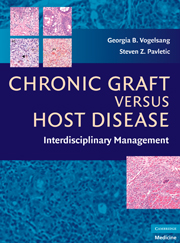Book contents
- Frontmatter
- Contents
- List of Contributors
- Preface
- PART I GENERAL PRINCIPLES
- PART II CLINICAL MANAGEMENT
- PART III ORGAN SITE OR SYSTEM-SPECIFIC MANIFESTATIONS
- 16 Cutaneous Manifestations of Chronic Graft versus Host Disease
- 17 Oral Chronic Graft versus Host Disease
- 18 Chronic Ocular Graft versus Host Disease
- 19 Gynecological Manifestations of Chronic Graft versus Host Disease
- 20 Gastrointestinal and Hepatic Manifestations of Chronic Graft versus Host Disease
- 21 Chronic Graft versus Host Disease and the Lung
- 22 Hematologic Complications of Chronic Graft versus Host Disease
- 23 Neurological Manifestations of Chronic Graft versus Host Disease
- 24 Rehabilitation Evaluation and Treatment of Patients with Chronic Graft versus Host Disease
- 25 Infections
- 26 Endocrine and Metabolic Effects of Chronic Graft versus Host Disease
- 27 Other Manifestations of Chronic Graft versus Host Disease
- 28 Psychosocial Issues in Chronic Graft versus Host Disease
- 29 Secondary Malignancies and Other Late Effects
- 30 Health-Related Quality of Life (HRQOL) in Chronic Graft versus Host Disease
- PART IV SPECIAL CONSIDERATIONS IN CHRONIC GVHD
- Index
- Plate section
26 - Endocrine and Metabolic Effects of Chronic Graft versus Host Disease
from PART III - ORGAN SITE OR SYSTEM-SPECIFIC MANIFESTATIONS
Published online by Cambridge University Press: 26 August 2009
- Frontmatter
- Contents
- List of Contributors
- Preface
- PART I GENERAL PRINCIPLES
- PART II CLINICAL MANAGEMENT
- PART III ORGAN SITE OR SYSTEM-SPECIFIC MANIFESTATIONS
- 16 Cutaneous Manifestations of Chronic Graft versus Host Disease
- 17 Oral Chronic Graft versus Host Disease
- 18 Chronic Ocular Graft versus Host Disease
- 19 Gynecological Manifestations of Chronic Graft versus Host Disease
- 20 Gastrointestinal and Hepatic Manifestations of Chronic Graft versus Host Disease
- 21 Chronic Graft versus Host Disease and the Lung
- 22 Hematologic Complications of Chronic Graft versus Host Disease
- 23 Neurological Manifestations of Chronic Graft versus Host Disease
- 24 Rehabilitation Evaluation and Treatment of Patients with Chronic Graft versus Host Disease
- 25 Infections
- 26 Endocrine and Metabolic Effects of Chronic Graft versus Host Disease
- 27 Other Manifestations of Chronic Graft versus Host Disease
- 28 Psychosocial Issues in Chronic Graft versus Host Disease
- 29 Secondary Malignancies and Other Late Effects
- 30 Health-Related Quality of Life (HRQOL) in Chronic Graft versus Host Disease
- PART IV SPECIAL CONSIDERATIONS IN CHRONIC GVHD
- Index
- Plate section
Summary
All recipients of hematopoietic cell transplantation (HCT) are at risk for late endocrine and metabolic dysfunction as a complication of the chemoradiotherapy given before HCT. However, these disturbances are often multifactorial. This chapter will focus on the endocrine and metabolic problems that arise predominantly as a result of chronic graft versus host disease (cGVHD) or therapies used to treat cGVHD (Table 26.1).
BONE METABOLISM
The two major iatrogenic complications of cGVHD that involve the skeleton are reduced bone mineral density and avascular bone necrosis (AVN).
Osteopenia and Osteoporosis
Definitions and Incidence
Dual energy x-ray absorptiometry (DEXA) is now the most common method for measuring bone mineral density (BMD). In adults, osteopenia is present when BMD in g/cm2 equates to a T-score of –1.0 to –2.4 standard deviations (SD) below mean BMD values for healthy young adults. Osteoporosis is present when the T-score is less than or equal to –2.5. In children, T-scores are not used because the DEXA scan will detect area-related increases in BMD associated with increased bone volume during normal growth and development leading to over diagnosis of osteoporosis. Instead, SD scores for children must be normalized according to age-related mean BMD values, giving rise to z-scores.
One prospective study found that 46% of adults had osteopenia or osteoporosis at 12 months after HCT. Other studies have shown that half of children have reduced BMD after HCT.
- Type
- Chapter
- Information
- Chronic Graft Versus Host DiseaseInterdisciplinary Management, pp. 289 - 301Publisher: Cambridge University PressPrint publication year: 2009



